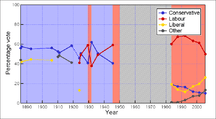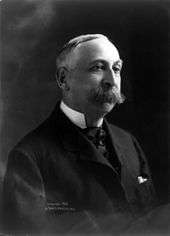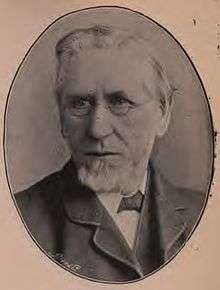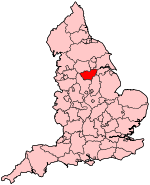Sheffield Central (UK Parliament constituency)
| Sheffield Central | |
|---|---|
|
Borough constituency for the House of Commons | |
|
Boundary of Sheffield Central in South Yorkshire. | |
|
Location of South Yorkshire within England. | |
| County | South Yorkshire |
| Electorate | 69,975 (December 2010) |
| Current constituency | |
| Created | 1983 |
| Member of parliament | Paul Blomfield (Labour) |
| Number of members | One |
| Created from | Sheffield Park, Sheffield Hillsborough, Sheffield Hallam and Sheffield Attercliffe[1] |
| 1885–1950 | |
| Number of members | One |
| Replaced by | Sheffield Neepsend |
| Created from | Sheffield |
| Overlaps | |
| European Parliament constituency | Yorkshire and the Humber |
Sheffield Central is a constituency[n 1] represented in the House of Commons of the UK Parliament since 2010 by Paul Blomfield, a member of the Labour Party.[n 2]
Boundaries
1885-1918: The Municipal Borough of Sheffield wards of St Peter's and St Philip's, and part of St George's ward.
1918-1950: The County Borough of Sheffield wards of St Peter's and St Philip's, and part of Broomhall ward.
1983-1997: The City of Sheffield wards of Burngreave, Castle, Manor, Netherthorpe, and Sharrow.
1997-2010: The City of Sheffield wards of Burngreave, Castle, Manor, Nether Edge, Netherthorpe, and Sharrow.
2010-2015: The City of Sheffield wards of Broomhill, Central, Manor Castle, Nether Edge, and Walkley.
2015-present: The whole of the City of Sheffield wards of Broomhill & Sharrow Vale, City, Manor Castle, Nether Edge & Sharrow, and Walkley; and parts of the wards of Crookes & Crosspool, Ecclesall, Fulwood and Hillsborough.
- Present boundaries
The seat covers central Sheffield and extends as far as Nether Edge and the Manor. It covers a similar area to the former Sheffield Park seat. It borders the constituencies of Sheffield Hallam, Sheffield Heeley, Sheffield Brightside and Hillsborough and Sheffield South East.
History
- 1885-1950
Created under the Redistribution of Seats Act 1885 for the election that year, Sheffield Central was one of five divisions of the former Sheffield constituency. Sheffield Central was abolished in 1950 and the sitting MP, Harry Morris, stood and won in the new seat (now extinct) of Sheffield Neepsend.
- 1983-date
In varied form the constituency was brought back into existence for the 1983 general election.
Labour's Richard Caborn represented Sheffield Central from its recreation in 1983 until he retired in 2010 and was narrowly succeeded at the ballot box by another Labour MP, Paul Blomfield.
Constituency profile
Whereas most of the Labour majorities since 1983 have been substantial meaning the area is potentially one of that party's safe seat's, in 2010 the Liberal Democrat share of the vote came 0.4% below that of the winning Labour candidate, which is highly marginal.
- In statistics
The constituency consists of Census Output Areas of a local government districts with: a working population whose income is close to the national average and lower than average reliance upon social housing.[2] At the end of 2012 the unemployment rate in the constituency stood as 4.0% of the population claiming jobseekers allowance, see table.[3]
| Sheffield's Seats Compared - worklessness[3] | |
|---|---|
| Office for National Statistics November 2012 | Jobseekers Claimant Count |
| Sheffield, Brightside and Hillsborough | 7.6%[n 3] |
| Sheffield Central | 4.0% |
| Sheffield Hallam | 1.5% |
| Sheffield Heeley | 5.7% |
| Sheffield South East | 4.4% |
The district contributing to the bulk of the seat has a medium 33% of its population without a car.[n 4] A medium 24.3% of the City's population are without qualifications, a high 15.8% of the population with level 3 qualifications and a medium 25.7% with level 4 qualifications or above. In terms of tenure a relatively low 58.3% of homes are owned outright or on a mortgage by occupants as at the 2011 census across the district.[4]
Members of Parliament
| Year | Member[5] | Party | Subsequent Roles | |
|---|---|---|---|---|
| 1885 | Howard Vincent | Conservative | ||
| 1908 | James Hope | Conservative | Lord Rankeillour | |
| 1929 | Philip Hoffman | Labour | ||
| 1931 | William Boulton | Conservative | ||
| 1945 | Harry Morris | Labour | Lord Morris | |
| 1950 | Constituency Abolished | |||
| 1983 | Constituency Created | |||
| 1983 | Richard Caborn | Labour | ||
| 2010 | Paul Blomfield | Labour | ||
Elections

| Party | Candidate | Votes | % | ± | |
|---|---|---|---|---|---|
| Green | Natalie Bennett[6] | ||||
Elections in the 2010s
| Party | Candidate | Votes | % | ± | |
|---|---|---|---|---|---|
| Labour | Paul Blomfield | 24,308 | 55.0 | +13.7 | |
| Green | Jillian Creasy | 6,999 | 15.8 | +12.1 | |
| Conservative | Stephanie Roe | 4,917 | 11.1 | +1.0 | |
| Liberal Democrat | Joe Otten | 4,278 | 9.7 | -31.2 | |
| UKIP | Dominic Cook | 3,296 | 7.5 | +5.9 | |
| Communist | Steve Andrew | 119 | 0.3 | +0.3 | |
| Pirate | Andy Halsall | 113 | 0.3 | N/A | |
| English Democrats | Elizabeth Breed | 68 | 0.2 | +0.2 | |
| Above and Beyond Party | Thom Brown | 42 | 0.1 | +0.1 | |
| Workers Revolutionary | Michael Driver | 33 | 0.1 | +0.1 | |
| Majority | 17,309 | 39.2 | +38.8 | ||
| Turnout | 44,173 | 57.4 | -2.2 | ||
| Labour hold | Swing | +0.8 | |||
| Party | Candidate | Votes | % | ± | |
|---|---|---|---|---|---|
| Labour | Paul Blomfield | 17,138 | 41.3 | -5.2 | |
| Liberal Democrat | Paul Scriven | 16,973 | 40.9 | +9.5 | |
| Conservative | Andrew Lee | 4,206 | 10.1 | +1.0 | |
| Green | Jillan Creasy | 1,556 | 3.8 | -2.0 | |
| BNP | Tracey Smith | 903 | 2.2 | +0.6 | |
| UKIP | Jeffrey Shaw | 652 | 1.6 | -0.1 | |
| Independent | Rod Rodgers | 40 | 0.1 | +0.1 | |
| Majority | 165 | 0.4 | -23.1 | ||
| Turnout | 41,468 | 59.6 | +4.6 | ||
| Labour hold | Swing | -7.4 | |||
Elections in the 2000s
| Party | Candidate | Votes | % | ± | |
|---|---|---|---|---|---|
| Labour | Richard Caborn | 14,950 | 49.9 | -11.5 | |
| Liberal Democrat | Ali Qadar | 7,895 | 26.3 | +6.6 | |
| Conservative | Samantha George | 3,094 | 10.3 | -0.6 | |
| Green | Bernard Little | 1,808 | 6.0 | +2.6 | |
| Respect | Maxine Bowler | 1,284 | 4.3 | N/A | |
| BNP | Mark Payne | 539 | 1.8 | N/A | |
| UKIP | Charlotte Arnott | 415 | 1.4 | +0.5 | |
| Majority | 7,055 | 23.5 | −18.2 | ||
| Turnout | 29,985 | 50.1 | +0.6 | ||
| Labour hold | Swing | -9.1 | |||
| Party | Candidate | Votes | % | ± | |
|---|---|---|---|---|---|
| Labour | Richard Caborn | 18,477 | 61.4 | -2.2 | |
| Liberal Democrat | Ali Qadar | 5,933 | 19.7 | +2.5 | |
| Conservative | Noelle Brelsford | 3,289 | 10.9 | -1.0 | |
| Green | Bernard Little | 1,008 | 3.4 | +0.7 | |
| Socialist Alliance | Nick Riley | 754 | 2.5 | N/A | |
| Socialist Labour | David Hadfield | 289 | 1.0 | N/A | |
| UKIP | Elizabeth Schofield | 257 | 0.9 | N/A | |
| Workers Revolutionary | Robert Driver | 62 | 0.2 | -0.0 | |
| Majority | 12,544 | 41.7 | −4.7 | ||
| Turnout | 30,069 | 49.5 | -3.6 | ||
| Labour hold | Swing | -2.36 | |||
Elections in the 1990s
| Party | Candidate | Votes | % | ± | |
|---|---|---|---|---|---|
| Labour | Richard Caborn | 23,179 | 63.6 | −5.1 | |
| Liberal Democrat | Ali Qadar | 6,273 | 17.2 | +5.6 | |
| Conservative | Martin Hess | 4,341 | 11.9 | −4.6 | |
| Green | Andy D'Agorne | 954 | 2.6 | +0.3 | |
| Referendum | Anthony Brownlow | 863 | 2.4 | N/A | |
| Socialist Alternative | Ken Douglas | 466 | 1.3 | N/A | |
| ProLife Alliance | Maureen Aitken | 280 | 0.8 | N/A | |
| Workers Revolutionary | Michael Driver | 63 | 0.2 | N/A | |
| Majority | 16,906 | 46.4 | −5.8 | ||
| Turnout | 36,419 | 53.0 | −3.1 | ||
| Labour hold | Swing | ||||
| Party | Candidate | Votes | % | ± | |
|---|---|---|---|---|---|
| Labour | Richard Caborn | 22,764 | 68.7 | +1.0 | |
| Conservative | Vernon Davies | 5,470 | 16.5 | −0.6 | |
| Liberal Democrat | Andrew Sangar | 3,856 | 11.6 | −2.3 | |
| Green | Graham Wroe | 750 | 2.3 | N/A | |
| End Unemployment Vote Justice for Jobless | M. Clarke | 212 | 0.6 | N/A | |
| Communist League | J. O'Brien | 92 | 0.3 | N/A | |
| Majority | 17,294 | 52.2 | +1.5 | ||
| Turnout | 33,144 | 56.1 | −5.4 | ||
| Labour hold | Swing | ||||
Elections in the 1980s
| Party | Candidate | Votes | % | ± | |
|---|---|---|---|---|---|
| Labour | Richard Caborn | 25,872 | 67.7 | +7.5 | |
| Conservative | Brian Oxley | 6,530 | 17.1 | −2.1 | |
| SDP–Liberal Alliance | Fiona Hornby | 5,314 | 13.9 | −5.5 | |
| Red Front | C. T. Dingle | 278 | 0.7 | N/A | |
| Communist | Keith Petts | 203 | 0.5 | −0.2 | |
| Majority | 19,342 | 50.7 | +9.9 | ||
| Turnout | 38,197 | 62.5 | +0.9 | ||
| Labour hold | Swing | ||||
| Party | Candidate | Votes | % | ± | |
|---|---|---|---|---|---|
| Labour | Richard Caborn | 24,759 | 60.2 | N/A | |
| SDP–Liberal Alliance | Patricia Major | 7,969 | 19.4 | N/A | |
| Conservative | Patricia Rawlings | 7,908 | 19.2 | N/A | |
| Communist | Vi Gill | 296 | 0.7 | N/A | |
| Revolutionary Communist | C. Barrett | 222 | 0.5 | N/A | |
| Majority | 16,790 | 40.8 | N/A | ||
| Turnout | 41154 | 61.6 | N/A | ||
| Labour win (new seat) | |||||
Elections in the 1940s
| Party | Candidate | Votes | % | ± | |
|---|---|---|---|---|---|
| Labour | Harry Morris | 7,954 | 59.2 | +10.0 | |
| Conservative | George Vivian Hunt | 5,481 | 40.8 | −10.0 | |
| Majority | 2,473 | 18.4 | +16.8 | ||
| Turnout | 72.0 | -2.2 | |||
| Labour gain from Conservative | Swing | ||||
Elections in the 1930s
| Party | Candidate | Votes | % | ± | |
|---|---|---|---|---|---|
| Conservative | William Whytehead Boulton | 13,821 | 50.8 | −11.2 | |
| Labour | Philip Christopher Hoffman | 13,408 | 49.2 | +11.2 | |
| Majority | 420 | 1.6 | -22.4 | ||
| Turnout | 74.2 | -6.0 | |||
| Conservative hold | Swing | ||||
| Party | Candidate | Votes | % | ± | |
|---|---|---|---|---|---|
| Conservative | William Whytehead Boulton | 21,589 | 62.0 | ||
| Labour | Philip Hoffman | 13,212 | 38.0 | ||
| Majority | 8,377 | 24.0 | |||
| Turnout | 80.2 | ||||
| Conservative gain from Labour | Swing | ||||
Elections in the 1920s
| Party | Candidate | Votes | % | ± | |
|---|---|---|---|---|---|
| Labour | Philip Christopher Hoffman | 19,183 | 59.1 | +8.5 | |
| Unionist | John Ralph Patientins Warde-Aldam | 13,284 | 40.9 | -8.5 | |
| Majority | 5,899 | 18.2 | 17.0 | ||
| Turnout | 74.1 | -0.4 | |||
| Labour gain from Unionist | Swing | +8.5 | |||
| Party | Candidate | Votes | % | ± | |
|---|---|---|---|---|---|
| Conservative | James Fitzalan Hope | 13,302 | 50.6 | ||
| Labour | Tom Snowden | 12,995 | 49.4 | ||
| Majority | 307 | 1.2 | |||
| Turnout | 74.5 | ||||
| Conservative hold | Swing | ||||
| Party | Candidate | Votes | % | ± | |
|---|---|---|---|---|---|
| Unionist | James Fitzalan Hope | 9,727 | 45.7 | n/a | |
| Labour | Tom Snowden | 8,762 | 41.1 | n/a | |
| Liberal | John Henry Freeborough | 2,810 | 13.2 | n/a | |
| Majority | 965 | 4.6 | n/a | ||
| Turnout | 61.3 | n/a | |||
| Unionist hold | Swing | n/a | |||
In the 1922 general election, James Fitzalan Hope was elected unopposed.[21]
Elections in the 1910s
| Party | Candidate | Votes | % | ± | |
|---|---|---|---|---|---|
| Conservative | James Fitzalan Hope | 9,361 | 58.7 | ||
| Independent Labour | Alfred James Bailey | 5,959 | 37.3 | ||
| British Socialist Party | Robert George Murray | 643 | 4.0 | ||
| Majority | 3,402 | 21.4 | |||
| Turnout | 43.1 | ||||
| Conservative hold | Swing | ||||
| Party | Candidate | Votes | % | ± | |
|---|---|---|---|---|---|
| Conservative | James Fitzalan Hope | 3,455 | 51.4 | ||
| Lib-Lab | Alfred James Bailey | 3,271 | 48.6 | ||
| Majority | 184 | 2.8 | |||
| Turnout | 77.5 | ||||
| Conservative hold | Swing | ||||
| Party | Candidate | Votes | % | ± | |
|---|---|---|---|---|---|
| Conservative | James Fitzalan Hope | 3,829 | 52.7 | ||
| Lib-Lab | Alfred James Bailey | 3,440 | 47.3 | ||
| Majority | 389 | 5.4 | |||
| Turnout | 83.7 | ||||
| Conservative hold | Swing | ||||
Elections in the 1900s
At the Sheffield Central by-election, 1908, James Fitzalan Hope was elected unopposed.[23]

| Party | Candidate | Votes | % | ± | |
|---|---|---|---|---|---|
| Conservative | Charles Edward Howard Vincent | 4,217 | 56.2 | ||
| Liberal | Stanley Udale | 3,290 | 43.8 | ||
| Majority | 927 | 12.4 | |||
| Turnout | |||||
| Conservative hold | Swing | ||||
In the 1900 general election, Charles Edward Howard Vincent was elected unopposed.[22]
Elections in the 1890s
In the 1895 general election, Charles Edward Howard Vincent was elected unopposed.[22]

| Party | Candidate | Votes | % | ± | |
|---|---|---|---|---|---|
| Conservative | Charles Edward Howard Vincent | 4,474 | 55.3 | ||
| Liberal | Robert Cameron | 3,618 | 44.7 | ||
| Majority | 856 | 10.6 | |||
| Turnout | 83.2 | ||||
| Conservative hold | Swing | ||||
Elections in the 1880s
| Party | Candidate | Votes | % | ± | |
|---|---|---|---|---|---|
| Conservative | Charles Edward Howard Vincent | 4,522 | 57.6 | ||
| Liberal | Joshua Hawkins | 3,326 | 42.4 | ||
| Majority | 1,196 | 15.2 | |||
| Turnout | 79.1 | ||||
| Conservative hold | Swing | ||||

| Party | Candidate | Votes | % | ± | |
|---|---|---|---|---|---|
| Conservative | Charles Edward Howard Vincent | 4,633 | 56.1 | ||
| Lib-Lab | Samuel Plimsoll | 3,484 | 42.2 | ||
| Independent Liberal | Mervyn L. Hawkes | 140 | 1.7 | ||
| Majority | 1,149 | 13.9 | |||
| Turnout | |||||
| Conservative hold | Swing | ||||
See also
Notes and references
- Notes
- ↑ A borough constituency (for the purposes of election expenses and type of returning officer)
- ↑ As with all constituencies, the constituency elects one Member of Parliament (MP) by the first past the post system of election at least every five years.
- ↑ This seat also saw the widest gender disparity with 10.5% of men were claimants, vs. 4.8% of women
- ↑ This falls within the centrally coloured banding for metropolitan areas
- References
- ↑ "'Sheffield Central', June 1983 up to May 1997". ElectionWeb Project. Cognitive Computing Limited. Retrieved 14 March 2016.
- ↑ 2001 Census
- 1 2 3 4 Unemployment claimants by constituency The Guardian
- ↑ 2011 census interactive maps
- ↑ Leigh Rayment's Historical List of MPs – Constituencies beginning with "S" (part 3)
- ↑ http://www.bbc.com/news/uk-england-south-yorkshire-37585844
- ↑ "Election Data 2015". Electoral Calculus. Archived from the original on 17 October 2015. Retrieved 17 October 2015.
- ↑ "Sheffield Central Parliamentary constituency". BBC News.
- ↑ "Election Data 2010". Electoral Calculus. Archived from the original on 17 October 2015. Retrieved 17 October 2015.
- ↑ "UK > England > Yorkshire & the Humber > Sheffield Central". Election 2010. BBC. 7 May 2010. Retrieved 11 May 2010.
- ↑ "Election Data 2005". Electoral Calculus. Archived from the original on 15 October 2011. Retrieved 18 October 2015.
- ↑ BBC Election 2005
- ↑ "Election Data 2001". Electoral Calculus. Archived from the original on 15 October 2011. Retrieved 18 October 2015.
- ↑ BBC Vote 2001
- ↑ "Election Data 1997". Electoral Calculus. Archived from the original on 15 October 2011. Retrieved 18 October 2015.
- 1 2 3 4 5 Sheffield General Election Results 1945 - 2001, Sheffield City Council
- ↑ "Election Data 1992". Electoral Calculus. Archived from the original on 15 October 2011. Retrieved 18 October 2015.
- ↑ "Election Data 1987". Electoral Calculus. Archived from the original on 15 October 2011. Retrieved 18 October 2015.
- 1 2 Richard Kimber's Political Science Resources
- ↑ "Election Data 1983". Electoral Calculus. Archived from the original on 15 October 2011. Retrieved 18 October 2015.
- 1 2 3 4 5 6 7 8 Craig, F. W. S. (1983) [1969]. British parliamentary election results 1918-1949 (3rd ed.). Chichester: Parliamentary Research Services. ISBN 0-900178-06-X.
- 1 2 3 4 5 6 7 8 British Parliamentary Election Results 1885-1918, F. W. S. Craig
- ↑ Whittaker's Almanack (1910), p.159

